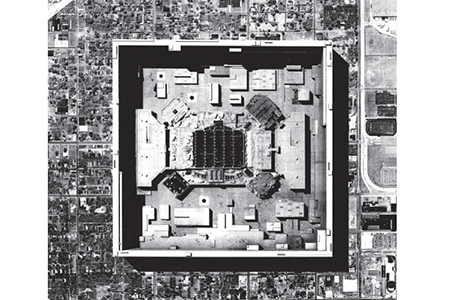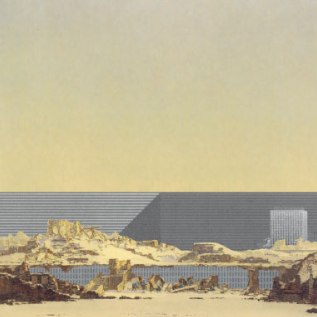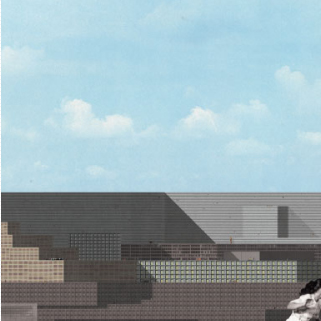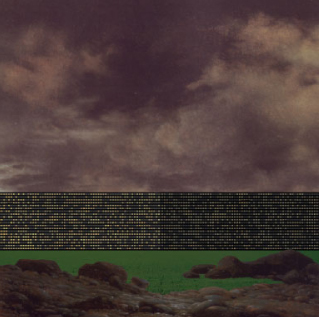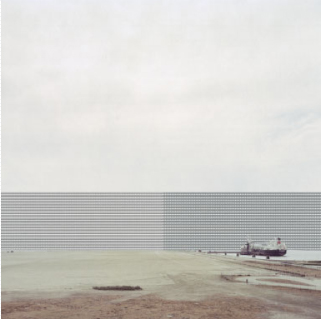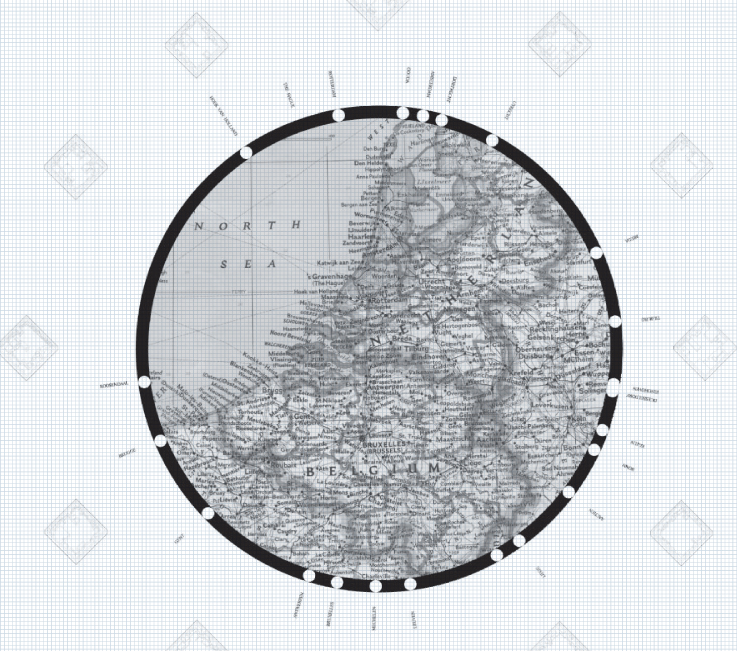
A Simple Heart: Architecture on Ruins of the Post-Fordist City, European North Western Metropolitan Area, 2002–09
by Dogma (Pier Vittorio Aureli, Martino Tattara with Alice Bulla)
The following proposes an idea of the city based on architecture. It is a well-known fact that, unlike the ancient city that was primarily made with architecture, the modern city is characterised by a great divergence between the scale of architectural form and the urban dimension. While the modern city is made of urbanisation, the extensive apparatus of governance and inhabitation, architectural form always addresses the possibility of a singular and finite form within the space of urbanisation.
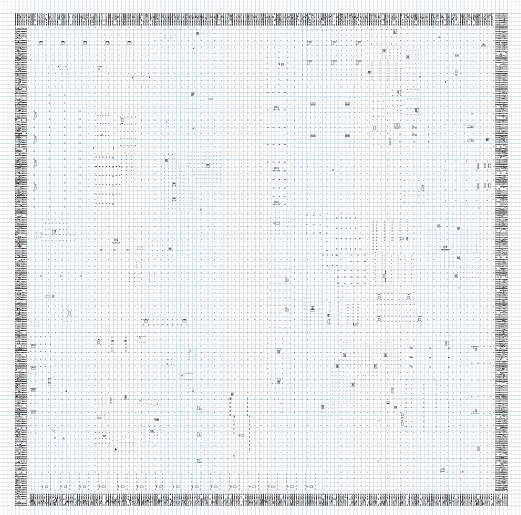
In order to make the city, architecture must be conceived as an example that is a form potentially repeatable without presuming that these repetitions are exactly the same. The example functions as an archetype: a singular form that due to the clear exhibition of its generative principle is able to define a milieu of possible forms. While a type is never reducible to a singular form and it can only emerge from a variety of forms, the archetype is always put forward by the individualisation of a precise and recognisable form. For this reason, while the type indicates a model of design based on the concept of evolution, the project of an example is always based on the idea of decision. The exemplary form has the authoritativeness of a decided form, yet it is not based upon the normative character typical of planning.
Whether it is a question of the distribution of different typologies, of different heights of the buildings, of the design of the green areas or of the circulation, the exemplary form elaborates archetypical actions. These actions are capable of blossoming into new combinations of the artificial and the natural, the technical and the formal, the structural and the accidental. It is, in short, a form that consists of one sole individual: the exemplary unit. For this reason, the example may be reproduced, but never proliferated into an omnivorous “general planning” for the entire city. [2]
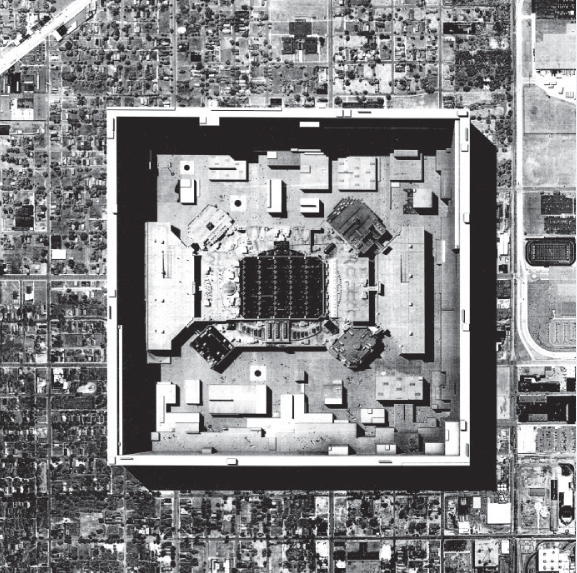
A Simple Heart is a project for the European city. It consists of 22 inhabitable units, each located close to the railway network that serves the European North Western Metropolitan Area (NWMA). Each unit is established by enclosing an area of 800 x 800 metres (2,624 x 2,624 feet) of an existing tertiary district by means of an inhabitable wall. The section of the enclosing wall is 25 metres (82 feet) thick and 20 storeys high and contains 860 hotel rooms, each measuring 19.20 x 2.60 metres (62.9 x 8.5 feet) to accommodate one or two people each.
Once the enclosure of an area is completed, a transparent roof supported by a 10 x 10-metre (32.8 x 32.8-foot) grid of columns 10 metres high is built in order to cover the space in between the buildings within the enclosure. In this way the entire enclosed area is transformed into a continuous interior made of multiple spaces such as streets, squares, doorways, galleries, corridors and rooms. Inside the new structure these spaces are relics and as such they will be used, transformed, reused and, eventually, destroyed by their inhabitants.
The interior space is intended as a vast open “living room”, a contemporary production space where living, social exchange and work take place within the same space. The rooms located in the walls are intended as a space of rest, solitude and seclusion.
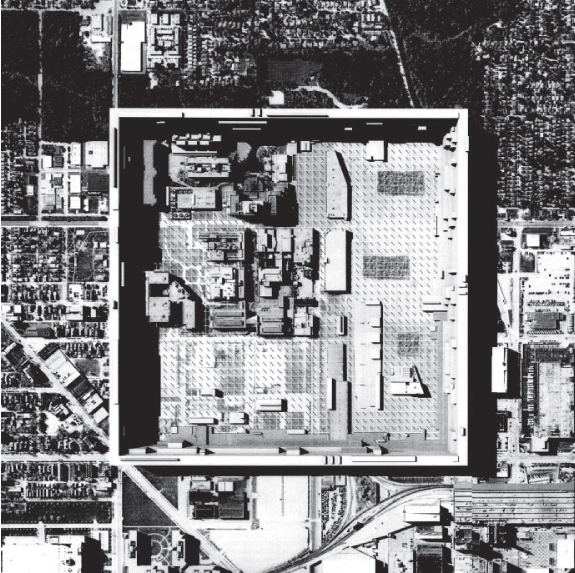
The 22 units are placed in proximity to the cities of Amsterdam, The Hague, Delft, Rotterdam, Antwerp, Brussels, Liège, Cologne, Dusseldorf, Aachen and Utrecht. The units are conceived as “learning centres” located along the railway circuit that links these cities. They are the places where the productive side of knowledge and social exchange becomes explicit. As such, the entire system is conceived as an “Edufactory”, a new contemporary production plant in which the Fordist machines are replaced by what constitutes the core of production today: immaterial work and its manifestation as the possibility of encounter and exchange. Mobility within this system is increased by the units’ proximity to the railway network. The system is a university campus whose form is enlarged to the scale of an urban region such as that of the European North Western Metropolitan Area.
Named after Gustave Flaubert’s short novel “Un coeur simple” (1877), in which the French writer celebrated the ardent integrity and naivety of a humble servant against self-referential sophistications of bourgeois mentality, the project ultimately celebrates the power of form in framing and defining the space of existence against the fragmentation perpetrated by contemporary urbanisation. [3]
In the 1960s, Cedric Price proposed converting the rusting railway network that served the industrial area of north Staffordshire in the UK into an educational campus. Price proposed the educational learning apparatus as mobile, flexible and constantly subjected to being adapted to the demands of technological development with its offspring of labour skills. Ironically, within the post-Fordist scenario of today’s capitalism, Price’s vision for the Potteries Thinkbelt (1964–6) is no longer a visionary project for the future but a description of the reality of today. Price attempted to counter the decline of an industrial site by transforming it into an educational campus; in so doing he (unconsciously) anticipated the passage from a Fordist mode of production to a post-Fordist one. If Fordism was based on the manufacturing of material goods, post-Fordism is based on the productive performance of language and communication. In post-Fordism, production of material goods remains in general a salient part of production, but ‘immaterial’ production (ideas, images, affects, social exchange) is decisive in leading the trends of production. Within the political economy of post-Fordism, the production of knowledge is far more important than its (eventual) application to the production of material goods.
For this reason, within post-Fordism, the institution of the university has become a fundamental productive unit. If once the ivory tower of knowledge was completely separated from the city, and especially from the city’s centres of production such as the factory, today the complex social and physical fabric of the university often coincides with the one of the city, to the point that the city itself has become a vast campus.
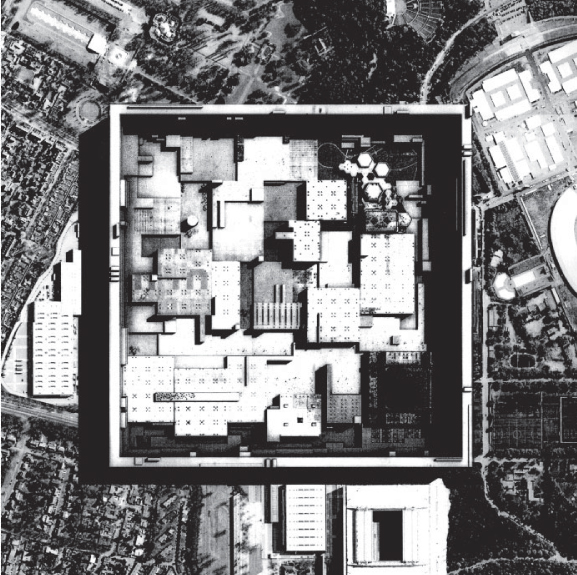
Price’s proposal for the Potteries Thinkbelt can be understood as the map of this transformation. By relying on the existing rail network, he proposed to go beyond the traditional campus typology, by assuming the territory and its transport connections as the new scale of the learning process. Moreover, his proposal questioned the strict separation of disciplines, and proposed instead the development of interchangeable units that would allow the learning process to be constantly re-formable according to the demands posed by the current economic developments. With the Potteries Thinkbelt project, Price proposed articulating knowledge, flexibility and territory into one system, not as a new typology for learning, but as a new urban model, as an archetype for the city. Yet readings of his Potteries Thinkbelt project have focused on the utopian side of his progressive plea for flexibility, multidisciplinary and dispersion of knowledge into the networked territory, and have overlooked how this has anticipated the way post-Fordist capitalism has completely subsumed the university (and the city itself) within its diffuse mode of production.
If Price proposed converting an industrial site into a postindustrial space for learning, DOGMA’s A Simple Heart assumes the postindustrial city is a potential space for the contemporary expanded university by making explicit the city as a ‘social factory’. As Price proposed the groundwork for the post-Fordist city on the ruins of the Fordist one, A Simple Heart proposes building the new city on the ruins of the post-Fordist city. These ruins are the stations, metro lines, chain shops, office blocks and meeting places that form the background to our “productive” lives in the city.
Instead of undoing Price’s proposal, A Simple Heart aims at revealing its fundamental political potential by radicalising it. This consists in increasing the openness and flexibility of the spaces of learning in order to reveal the common and generic attributes of knowledge.
In the Fordist city the “machines” were the assembly line, the processes of assembling material goods. In that factory, most of the workers were supposed to be silent controllers of the assembly line. In the post-Fordist factory, where productive labour invests all aspects of human relationships and takes the form of language and communication, machines are replaced by living labour – the workers themselves and their possible cooperation. Within this condition, architecture is completely liberated from any functionalist or programmatic duty, and it serves production only by means of being there as a framework, as place. However, we do not need to understand this liberation of architecture from programme as a plea for a generic “free space”. The liberation of architecture from a programmatic definition signals the opposite: that space has been completely subsumed by production. For this reason the traditional partitions of the city such as those between public and private space, or those between different activities such as work and living, culture and market are no longer relevant. If these partitions still exist, they simply act as ideological projection, as a mask that covers the “generic field” that supports the reproduction of productive labour. This generic field is the life of the social factory made by continuous mobility, and thus uprootedness, poverty of specialised instincts, common places, precariousness of life. A Simple Heart is the utmost embodiment of this condition, and at the same time the frame holding it.
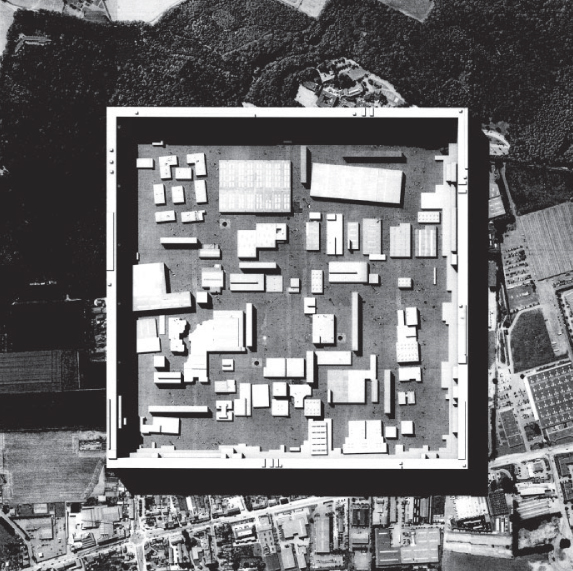
A building is thus the best analogy in order to understand the biblical concept of the Katechon; like in the Katechon, a building has to hold the forces that might want to transgress its order and should accommodate them through the management of the spaces so that at the same time, the same forces are restrained. The concept of the Katechon does not imply the negation of the forces of mobility, genericity and precariousness; it implies a form that resists these forces by adhering to them, just as the concave adheres (and thus defi nes) the convex. As a consequence, architectural form is reduced to its essential nature in order to stage and make visible not itself, but the life that happens within its limits.
